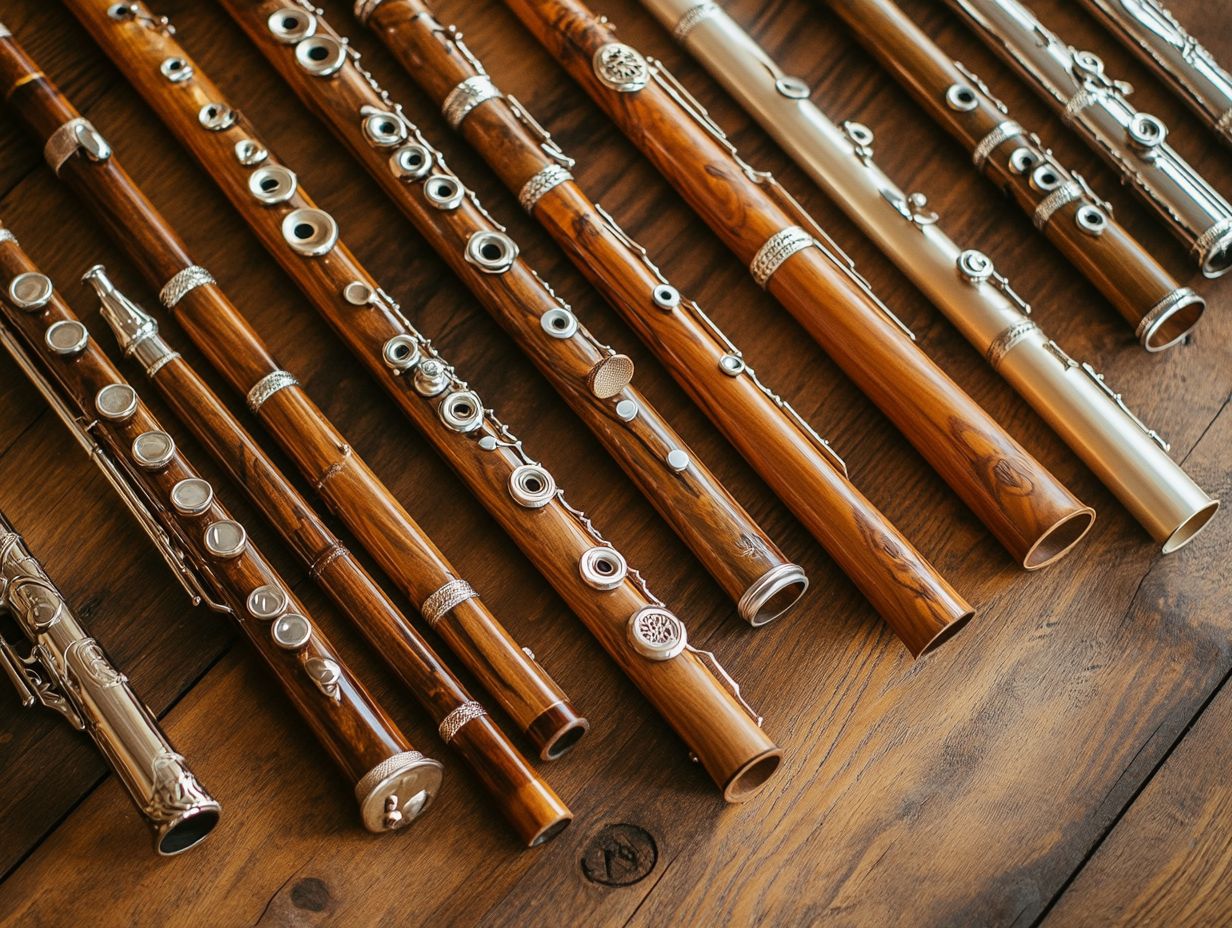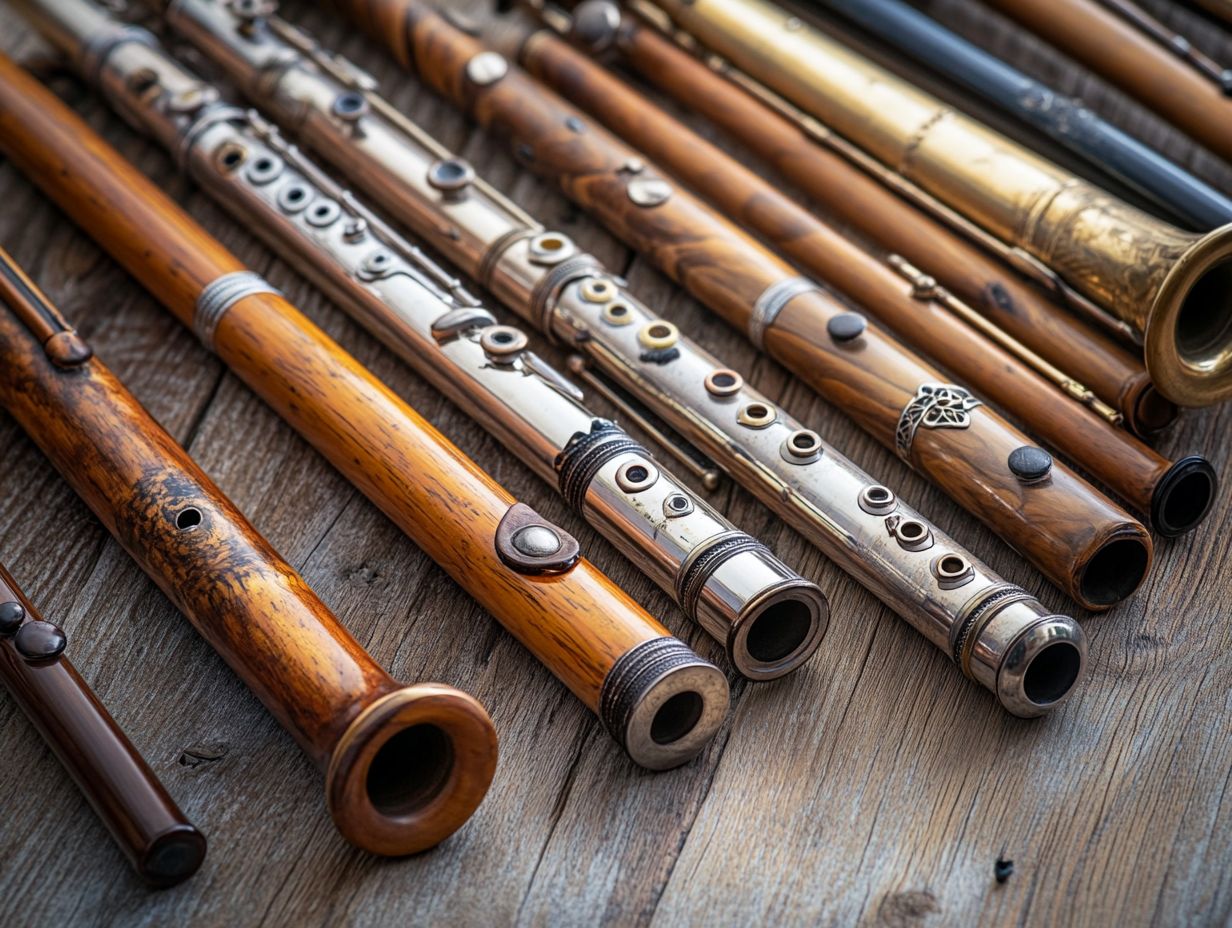The flute is one of the oldest instruments in history, boasting a rich evolution that has captivated both musicians and listeners alike. From its ancient origins to its modern-day versatility, the flute has played a significant role in a variety of musical genres, showcasing its adaptability and charm.
This article delves into the fascinating history of the flute, highlights notable composers, introduces different types of flutes, and celebrates the instrument’s impact on contemporary music. It also discusses the physical and mental benefits of playing the flute, offers tips for beginners, and provides an insight into the art of flute-making.
Join us on this melodious journey!
Contents
History of the Flute

The history of the flute spans thousands of years, beginning with ancient civilizations that crafted the woodwind instrument from bamboo and bone. Over time, the flute has evolved and adapted to various cultural and musical contexts, ranging from the simple melodic lines of Renaissance music to the intricate performances of Baroque music.
This evolution highlights the instrument’s craftsmanship and its enduring cultural significance.
Origins and Evolution
The origins and evolution of the flute illustrate the transformation of an ancient instrument, originally made from natural materials like bamboo and wood, into the sophisticated silver flute used in modern orchestral music today. This transformation not only highlights advancements in craftsmanship but also emphasizes the diverse cultural contexts in which the flute has thrived.
Early versions of the instrument can be traced back thousands of years, existing in various forms around the world. For instance, the bamboo flute of Asia plays a significant role in traditional music, while the elegant silver flute is favored in Western classical compositions.
Each type of flute possesses its own distinctive sound and character, reflecting the musical heritage of its origins. The evolution of this instrument encompasses both aesthetic changes and musical innovations, showcasing its adaptability across genres and cultures.
Notable Figures and Composers
Throughout musical history, composers and other influential figures have elevated the status of the flute, expanding its repertoire and showcasing the instrument’s versatility in classical music and beyond.
Notable composers include J.S. Bach, whose early works for the flute broadened the instrument’s range and set a precedent for future composers. The 18th-century virtuoso Quantz contributed significantly by writing a highly regarded treatise that analyzed the mechanics of flute playing and enhanced the understanding of its capabilities.
In the 19th century, composers such as Mozart and Debussy further highlighted the flute’s potential by integrating it into larger orchestral contexts and experimenting with its sound in iconic compositions.
Types of Flutes

There are various types of flutes, including historical instruments like the Baroque flute and the Renaissance flute, which help recreate the sounds of the past.
Along with these, modern flutes such as the piccolo, alto flute, and bass flute, along with the concert flute, provide a diverse range of tonal and acoustic properties that cater to different musical styles and performance practices.
Overview of Different Flute Variants
The types of flutes discussed in the following sections each possess unique characteristics and cultural backgrounds, including the bamboo flute, silver flute, Irish flute, and Native American flute. Together, they contribute to a rich variety of sounds across different musical genres.
Flute Types by Material
Bamboo Flute
Bamboo is a widely used material for making folk instruments due to its affordability and abundance. The bamboo flute is commonly found in Indian music, where its sound evokes feelings of spontaneity and intimacy. This flute is distinguished by its half-moon-shaped embouchure, and it is played in a flowing, expressive style typical of Eastern musical traditions.
Silver Flute
The silver flute, primarily made from silver and other metals, is the most prevalent type of Western flute. It features an airy and bright tonal quality and is typically used in Western classical music settings. Players often employ formal Western classical techniques, such as vibrato and breath control, when playing this instrument.
Folk Flutes
The Irish flute, with its simple key structure and wooden embouchure hole, embodies a distinctly folk aesthetic similar to that of the silver flute. It is often played in group sessions, where musicians gather to perform traditional Irish music through lively jigs and reels. The tin whistle, or penny whistle, is another traditional Irish woodwind instrument favored by amateur musicians.
The Native American flute, generally crafted from wood or bamboo, is designed for improvisation. It is typically played in a relaxed, almost meditative style that fosters a deep spiritual connection. Often associated with storytelling, the Native American flute captures the sounds of nature.
Family of Flute Instruments
While other wind instruments, such as the recorder and saxophone, are not technically classified as flutes, they share many playing techniques, tonal qualities, and musical aspects used in flute performances. Consequently, many of the cultural and musical features of these instruments overlap with those of traditional flutes.
Collectively, these various types of flutes not only enhance musical performances but also connect different cultural contexts, while still conveying the unique stories of each instrument.
The Flute in Modern Music
The flute is utilized in a diverse range of musical styles today, including orchestral music, jazz, and world music. This highlights the instrument’s versatility and its ability to adapt to various performance practices.
Influence and Popularity in Different Genres

The flute is widely popular across various musical genres, including orchestral music, folk music, jazz, as well as at musical events, competitions, and festivals. In orchestral music, the flute plays a crucial role, serving as a staple instrument in most orchestras. It is often featured in concertos, where it may be played solo or in small groups. The sound of the flute adds a beautiful and rich texture to orchestral compositions, whether as a soloist or as part of an ensemble.
In folk music, the flute is integral to many traditions worldwide. Folk flute music often serves to preserve cultural heritage while bringing people together through storytelling and shared experiences. In various cultures, it is commonly used during celebrations, ceremonies, and social gatherings, fostering a sense of community.
In jazz music, the flute is typically used as a secondary instrument, but its improvisational capabilities make it a valuable addition to the genre. Jazz flutists frequently employ a wide range of techniques, including flutter-tonguing, multiphonics, and extended techniques, to produce unique and expressive sounds that enhance the overall jazz experience.
Music events, competitions, and festivals often showcase flute performances that attract large audiences. These occasions provide platforms for flutists to demonstrate their talents, allowing spectators to appreciate the beauty and versatility of the flute in live performances.
Benefits of Playing the Flute
Playing the flute offers numerous advantages, including both physical and mental health benefits, as well as enhancements in music education through the development of vital skills such as breath control and finger technique.
Physical and Mental Health Benefits
Playing the flute offers profound physical and mental health benefits. This practice improves lung capacity and promotes relaxation, making it a valuable component of music therapy and sound healing.
By playing the flute, individuals can enhance the connection between breath and sound, while also improving posture, as flute players tend to adopt an upright position that supports the spine.
Additionally, the flute serves as a therapeutic tool, helping to reduce anxiety levels through soothing melodic expression. Research has shown that playing the flute can enhance cognitive function, as memory and concentration improve with the need to learn how to read music and develop various skills.
In music therapy, these benefits are utilized to facilitate emotional expression and communication, proving especially advantageous for those facing challenges related to mental health or developmental disorders.
Learning and Mastering the Flute

Flute education encompasses the processes of learning and teaching the flute. It involves imparting flute playing techniques, utilizing effective teaching methods, and actively participating in both online and offline flute communities.
Tips for Beginners
For beginners learning to play the flute, the best approach involves establishing a regular practice routine, focusing on fundamental techniques, and engaging with supportive flute communities. It is advisable for beginners to create a practice schedule, dedicating at least 20-30 minutes each day to essential skills such as breath control, finger positioning, and tone quality.
They can enhance their practice by utilizing online resources, including instructional videos, sheet music websites, and mobile apps featuring interactive exercises. Additionally, connecting with fellow musicians through local music groups or online forums can offer valuable support and camaraderie, along with tips and feedback from more experienced players.
Having a mentor or taking lessons can further accelerate their progress and help maintain motivation.
Exploring the World of Flute-Making
The realm of flute-making offers in-depth explorations of the craftsmanship and design of both historical and contemporary flutes. It includes profiles of modern flute makers and detailed descriptions of their work.
Artisanal and Modern Techniques
The art of flute-making combines artisanal techniques with modern innovations to produce instruments that exhibit both exceptional craftsmanship and remarkable acoustic properties. Skilled flute makers often dedicate hundreds of hours to the meticulous handcrafting of their instruments, drawing on centuries-old traditions that include painstaking tasks such as creating their own keys and pads.
They typically select the highest quality woods and metals to produce a rich, warm sound that resonates emotionally with players. The hand-finishing processes involved in flute making result in subtle variations that can lead to unique tonal qualities, catering to musicians who seek an individualized voice.
In contrast, modern technological innovations, such as computer-aided design (CAD), enable manufacturers to create precise and highly consistent instruments. Computer-controlled precision machining allows for the development of intricate features, including adjustable keys and improved pads, which enhance comfort and mechanical performance.
Both artisanal and modern methods significantly influence sound quality and shape the overall experience flutists have when playing their instruments.
